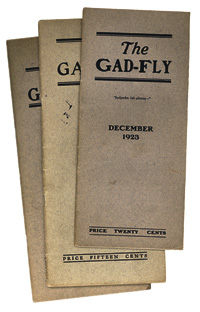Main Menu · Search ·Current Issue ·Contact ·Archives ·Centennial ·Letters to the Editor ·FAQs


![]()
"Among the collegiate herd of sacred cows and their worshippers now buzzes the gad-fly."
Thus did a new journal, put out by the Harvard Student Liberal Club, introduce itself in 1922. John Tileston Edsall '23, now a distinguished Harvard scientist, was The Gad-Fly's first editor. On his small staff was freshman J. Robert Oppenheimer '26.
Edsall has given the College Pump a set of The Gad-Fly "as a small remembrance of the way some people at Harvard were writing and thinking 75 years ago."
The Student Liberal Club, he notes, was housed on Winthrop Street. "It
served good luncheons and was a place for good talk. Some lasting friendships
were formed there." In his senior year, Edsall shared an upstairs suite of rooms
with classmate Robert Keith MacKaye, son of the poet and dramatist Percy MacKaye,
class of 1897. 
"The word 'liberal' raised some hackles then, as it does today," says Edsall. "The years after World War I were a time of turbulence and uncertainty. It was only five years since the Bolshevists had overthrown the imperial government of Russia, and threatened to overturn other governments." The Sacco-Vanzetti trial had stirred widespread hostility toward two philosophical anarchists who were aliens. Congress had enacted drastic immigration restrictions.
"In 1922 the officers of the Liberal Club decided to publish a magazine," Edsall recalls. "I remember little about the planning. What I do know is that I became editor, with a group of four associate editors: Peter Ferguson, Bernard Bechhoefer, Lyon Boston, and J. Robert Oppenheimer. I have memories of all, but to anyone today, Oppenheimer inevitably eclipses the others.
"Bob, as he was called then--he did not acquire the nickname 'Oppie' till years later--had been at Harvard only three months, but he was a person of such intellectual intensity that no one could ignore him. Moreover, he made an immediate contribution by giving the magazine its name. Drawing on Plato's Apology, in which Socrates describes himself as a gadfly who pesters the Athenian people, Bob proposed The Gad-Fly as our title. He also chose a brief quotation in the original Greek as an epigraph for our cover. It translated roughly as 'to be aroused by the gadfly,' and that fitted our intentions."
The Gad-Fly's first issue contained 20 pages of text and cost 15 cents. The content was varied and intellectually ambitious. Franklin Pollak '23 defended determinism; graduate student Charles Hartshorne, later a noted philosopher, rejected it. Lyon Boston '26 probed "The Soul of Japan." Harold Larrabee '16, an instructor, wrote on "classroom constraint." Edsall's roommate, MacKaye, contributed a poem called "The Russian Bell," inspired by the revolution. Edsall, who had taken only a single economics course, expatiated--"in a way that strikes me now as pretty naive"--on "The Experimental Attitude in Economics."
The editors sought to promote their product by announcing article titles and authors in advance. "Little did we know that the editors of the Lampoon were watching our every move and hatching a plot," recalls Edsall. "The day before The Gad-Fly's scheduled publication, a Lampoon parody appeared. It was printed in red ink to show what Bolshevists we were. The names of our authors had been suitably mutilated. Mine was twisted into 'Jehoboam Titticomb Pretzel.' Lyon Boston '26 was 'Lynn to Boston 26¢.'
"The Lampoon performed a service for us," adds Edsall. "I'm sure the parody boosted sales. Some people may have wanted to find out what this group of alleged Bolshevists was up to. Those who believed we were promoting revolution must have been sadly disappointed. The Gad-Fly was sold at several shops in the Square, not just bookstores. Greek shop-owners were pleased to see a Greek motto on the cover."
Like the fruit fly, The Gad-Fly had a short life. Its fourth issue, dated December 1925, was its last. Edsall was then doing advanced biochemistry at Cambridge University; others had taken charge of the journal. The final issue included an essay by Raphael Demos, Ph.D. '16, then an instructor in philosophy, and blank-verse poems by Sherry Mangan '25, a future journalist and poet, and Virgil Thomson '22, who would make his name as a composer.
Though young Bob Oppenheimer had given The Gad-Fly its title, his writing never appeared in its pages.
Edsall went on to do pioneering research and teaching in biochemistry, but his adventure in editing wasn't wasted. Harvard Magazine, in an article published in 1980, noted that "as an early editor of the Journal of Biological Chemistry,...he set high standards for scientific publications and profoundly influenced the shape of a growing science."
Now professor of biochemistry emeritus, Edsall can be found at the Fairchild Biochemistry Building, 7 Divinity Avenue, where he maintains a remarkably busy schedule. He observed his 95th birthday in November. Though The Gad-Fly no longer buzzes, its original editor does.
~Primus IV